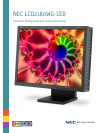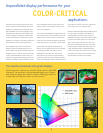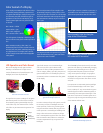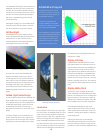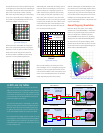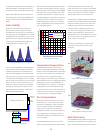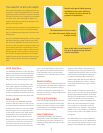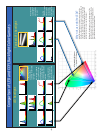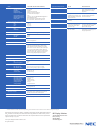
The LCD2180WG-LED display further increases the
displayable color gamut by using a custom modi-
fied color filter on the blue sub-pixels reducing
the amount of cyan that passes through. This has
the effect of increasing the blue gamut beyond
that which is achievable using a blue LED and
standard blue filter.
See diagram on page 9 for a more detailed expla-
nation of how the wide color gamut is achieved
and how it compares to a typical CCFL display.
LED Backlight
The backlight source for the display is a linear
array of 48 individual red (18), green (20) and blue
(10) power LEDs. The light from these LEDs is
combined together to form white light, which is
the backlight source for the LCD panel.
Each LED that is used in the LCD2180WG-LED
display is individually chosen using a rigorous
screening process for color spectrum and lumi-
nance output in order to achieve the maximum
possible color gamut and color uniformity across
the display screen. Only a very small fraction
of the LEDs produced by the manufacturer are
deemed acceptable and chosen for use in the
display.
Folded Light Guide Design
In order to allow the light from the individual red,
green and blue LEDs to mix together and appear
as a single white light source, the display features
a folded light guide design. Light from the row
of alternating colored LEDs is fed through a
light guide and curved mirrors at the rear of the
display.
This allows the light from the individual LEDs a
greater distance in which to mix together, thus
giving a much more uniform light source without
significantly increasing the depth of the display.
Luminance
When compared to CRT monitors, the high bright-
ness of the power LED backlight allows for a much
higher screen intensity (brightness) to be used.
A typical intensity of 160 cd/m
2
, regardless of the
white point setting, allows the display to be used
where traditionally a darkened room was neces-
sary. Also where direct side-by-side comparisons
with print samples in a light box were previously
difficult due to the difference in luminance, the
increased intensity of the display makes direct
comparisons a reality.
Display Lifetime
Commercial LEDs have been around since the
early 1960s, however it is only within the last 10
years that blue LEDs have become available, and
only within the last couple of years that ultra
high brightness LEDs capable of replacing CCFLs
have become available with a comparable power
consumption. One of the major benefits of LEDs,
besides the narrow output spectrum, is the long
lifetime of typically 50,000 hours. This compares
to a typical CCFL based display lifetime of 25,000
hours.
Display White Point
The intensity of the red, green and blue LEDs
can be individually controlled, allowing the white
point or color temperature of the resulting white
light to be adjusted. This represents a major ad-
vantage over traditional LCD displays that utilize
a CCFL backlight with a fixed color temperature.
In a traditional LCD display, the only way to
adjust the white point of the screen is by using
a look-up-table, which resides either in the host
computer’s video graphics adapter or internally
to the display itself.
Changing the white point from the display’s
native white point means that one or two colors
have to be reduced in luminance using the look-
up-table. This means that fewer displayable colors
AdobeRGB and beyond
Many mainstream output devices
such as ink jet printers can now pro-
duce colors that lie outside of even
the AdobeRGB colorspace.
The gamut of LCD2180WG-LED
exceeds AdobeRGB in the red and
magenta areas, making it possible to
view colors beyond AdobeRGB.
The LCD2180WG-LED display complies
with the new AdobeRGB (1998) Refer-
ence Viewing Environment specifi-
cation. A preset for matching the
AdobeRGB color gamut is available
via the On Screen Display menu.
Red, Green and Blue LED Array
Folded Light Guide and LED Array
4



